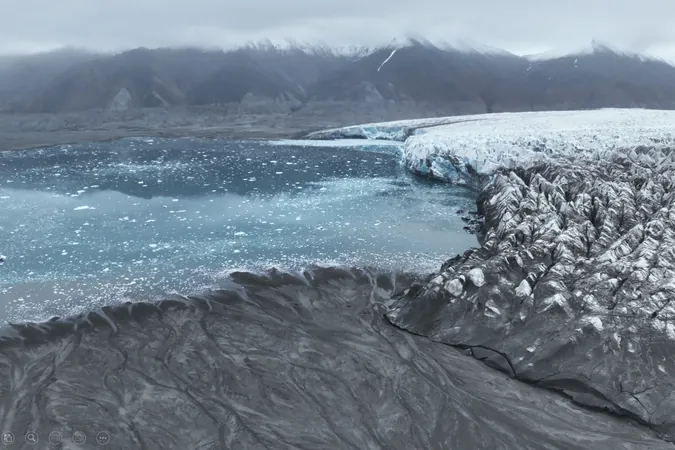
New Arctic Coastlines Revealed by Melting Glaciers: A Double-Edged Sword
2025-04-01
Author: Nur
A groundbreaking study has unveiled that retreating glaciers in the Arctic have created over 2,500 kilometers of “new” coastlines and 35 “new” islands between 2000 and 2020. The findings, published in Nature Climate Change, draw from extensive satellite imagery of more than 1,700 glaciers located in regions such as Greenland, Alaska, the Canadian Arctic, the Russian Arctic, Iceland, and Svalbard.
The research highlights that a staggering 85% of the glaciers surveyed have retreated over the two decades, exposing an average of 123 kilometers of new coastline each year. Notably, just 101 glaciers—less than 6% of the total—were responsible for more than half of this newly revealed coastline. The Zachariae Isstrom glacier in northeast Greenland alone accounted for an astonishing 81 kilometers of newly exposed coastline.
However, this alarming phenomenon comes with warnings: the newly formed coastlines are at greater risk for landslides, potentially giving rise to dangerous tsunamis that endanger human life and infrastructure. A scientist not involved in the study remarked that the implications of this transformation for Arctic communities and ecosystems remain “unclear.” Nevertheless, these newly exposed landscapes could serve as vital habitats for unquantified ecosystems that may play a crucial role in the global carbon cycle.
Glaciers, often described as slow-moving rivers of ice, are found on nearly every continent and are essential for regulating Earth’s freshwater supply. Unfortunately, global warming accelerates their melting, a process that leads to what scientists call "terminus retreat." From 2000 to 2019, glaciers worldwide lost approximately 267 billion tonnes of ice annually. S alarming reports predict that many of these glaciers could completely vanish in the coming decades, even if global warming is limited to 1.5°C.
Research indicates that marine-terminating glaciers, which flow into the ocean, are a significant contributor to new coastlines. Over the study period, they lost around 10 gigatonnes of mass each year due to terminus retreat. The implications of these findings are wide-ranging; rising temperatures not only threaten glacier stability but also the diverse ecosystems dependent on these environments.
The study meticulously assessed coastline changes using satellite images, particularly from the Sentinel-2 satellite, highlighting the variability of Arctic coastlines which complicate algorithm-based assessments. Researchers like Dr. Jan Kavan from the University of South Bohemia emphasized the labor-intensive yet essential nature of this manual analysis, given the irregularities often present within these regions.
Interestingly, the researchers found that not all glacier retreats resulted in new coastline exposure. Glaciers extending significantly into the sea could retreat extensively without producing new coastlines. Conversely, glaciers in narrow fjords may expose long stretches of coastal land with minimal ice loss.
While glacier-related advances can lead to reductions in coastline, the dramatic retreats are primarily attributed to ice shelf collapses. The research found that more than 50 meters of coastline was lost due to such glacier advances— with significant contributions from the Nathorstbreen glacier system in Svalbard.
Another key takeaway from the study is the nature of the newly revealed coastlines as “paraglacial.” These areas lack established permafrost, rendering them more susceptible to erosion and abrupt changes due to wave action. The dynamics of these coastlines raise considerable uncertainty about their future ecological roles and the potential risks they pose, particularly concerning tsunamis and infrastructure damage—a reality seen in the tragic Greenland tsunami of June 17, 2017.
Researchers warn that further in-depth analyses are necessary to assess local risks where communities might be in danger from this newly exposed terrain. In the bigger picture, the melting of these glaciers—considered "biodiversity hotspots"—suggests that valuable Arctic habitats could be lost, endangering species such as bearded seals and Arctic birds.
As the Arctic continues to undergo significant transformations from climate change, understanding these new coastlines and their implications becomes critical not just for the affected communities but for global ecological balance and climate responses.



 Brasil (PT)
Brasil (PT)
 Canada (EN)
Canada (EN)
 Chile (ES)
Chile (ES)
 Česko (CS)
Česko (CS)
 대한민국 (KO)
대한민국 (KO)
 España (ES)
España (ES)
 France (FR)
France (FR)
 Hong Kong (EN)
Hong Kong (EN)
 Italia (IT)
Italia (IT)
 日本 (JA)
日本 (JA)
 Magyarország (HU)
Magyarország (HU)
 Norge (NO)
Norge (NO)
 Polska (PL)
Polska (PL)
 Schweiz (DE)
Schweiz (DE)
 Singapore (EN)
Singapore (EN)
 Sverige (SV)
Sverige (SV)
 Suomi (FI)
Suomi (FI)
 Türkiye (TR)
Türkiye (TR)
 الإمارات العربية المتحدة (AR)
الإمارات العربية المتحدة (AR)